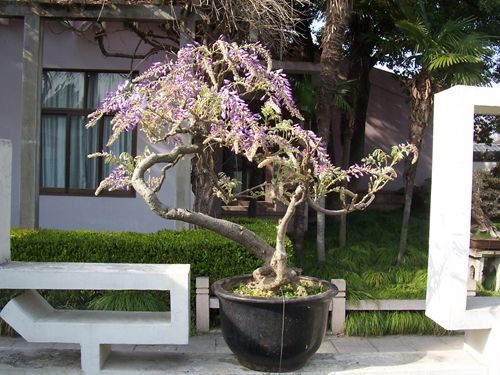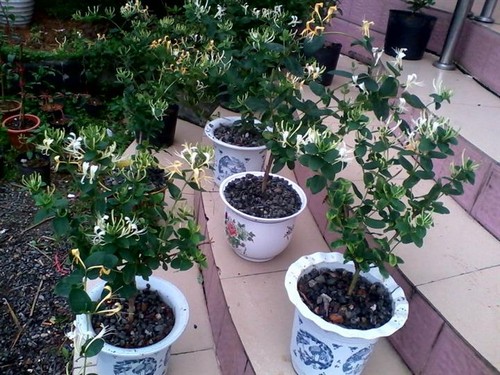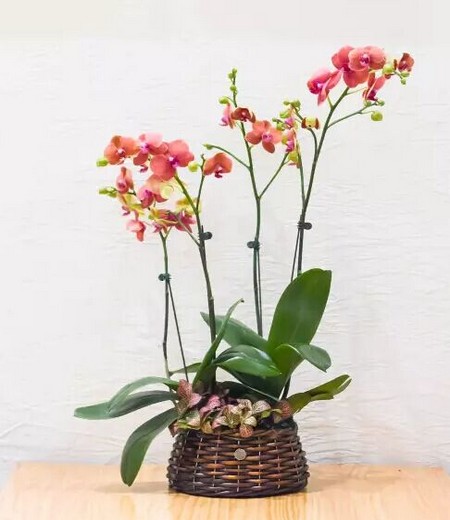Key points of planting techniques of wisteria bonsai
Wisteria has strong taproot, so it is advisable to dig lateral roots as much as possible and bring land when transplanting. More than planting in early spring, it is necessary to set up a frame before planting, and tie the coarse branches to the rack to make it climb along the shelf. Because of the long life of wisteria, thick branches and luxuriant leaves, the scaffolding material must be solid and durable. When young trees are first planted, the branches cannot form flower buds, and then there will be peanut buds. If planting for several years still does not blossom, first, because the tree is too prosperous, too many branches and leaves, second, the tree is weak, it is difficult to accumulate nutrients. The former adopts partial root cutting and thinning of branches and leaves, while the latter can blossom by adding fertilizer.

For potted wisteria, in addition to selecting shorter species and varieties, pruning and heart-picking should be strengthened to control the plant not to be too large. Such as bonsai cultivation, shaping, pruning more need to be strengthened, if necessary, you can also use the old pile on the basin, grafting excellent varieties.
In order to plant wisteria well, we should pay attention to the following problems:
Propagation: wisteria can be propagated by cutting, striping, sowing, grafting, tillering and other methods.
Soil: the main root of wisteria is long, so the planting place needs a deep soil layer. Wisteria is resistant to barren, but fertile soil is more favorable for growth. Wisteria is also adaptable to soil acidity and alkalinity.
Light: wisteria likes the sun and bears shade slightly. Because wisteria is a big vine, in order to make it grow well, it is generally set up a certain scaffolding for cultivation. Wisteria also has smaller species and varieties that can be used as potted plants or to make bonsai.
Location: in addition to the sunny and deep soil mentioned above, wisteria needs to be able to take shelter from the wind.
Temperature: wisteria is highly adaptable, heat-resistant and cold-resistant, and is cultivated in China from south to north. So in Guangdong, the temperature can adapt to wisteria all the year round.
Watering: the main root of wisteria is very deep, so it has a strong ability to withstand drought, but like wet soil, but can not let the root soak in water, otherwise it will rot.
Fertilization: wisteria can basically meet the needs by applying compound fertilizer 2 or 3 times a year. Fertilizer should be applied more potash fertilizer, generally topdressing 2 or 3 times during the growing period.
Pruning: after flowering, the middle branch can be cut short with 5-6 buds, and the weak branches can be cut off to promote the formation of flower buds.
Time: 2019-05-25 Click:
- Prev

How to grow honeysuckle
Honeysuckle is not only a commonly used medicine, but also a plant that can be used for viewing. Honeysuckle bonsai is also quite good-looking. So which of our honeysuckle planting techniques need special attention? First of all, land selection is very important. Honeysuckle planting still has high requirements for the environment.
- Next

Planting techniques of potted Phalaenopsis
The butterfly orchid gets its name from the shape of the butterfly, which means I love you and symbolizes nobility and elegance. It is one of the most popular flowers in the Spring Festival. It is favored by the world for its bright colors, diverse varieties and graceful posture. Festivals and high-end banquets are decorated with Phalaenopsis. Phalaenopsis can be put into pots or placed on a single plant.
Related
- Fuxing push coffee new agricultural production and marketing class: lack of small-scale processing plants
- Jujube rice field leisure farm deep ploughing Yilan for five years to create a space for organic food and play
- Nongyu Farm-A trial of organic papaya for brave women with advanced technology
- Four points for attention in the prevention and control of diseases and insect pests of edible fungi
- How to add nutrient solution to Edible Fungi
- Is there any good way to control edible fungus mites?
- Open Inoculation Technology of Edible Fungi
- Is there any clever way to use fertilizer for edible fungus in winter?
- What agents are used to kill the pathogens of edible fungi in the mushroom shed?
- Rapid drying of Edible Fungi

